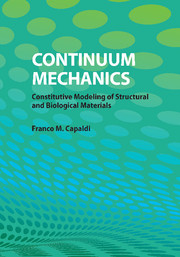6 - Fluids
Published online by Cambridge University Press: 05 August 2012
Summary
The response of a fluid depends on the rate of deformation. In this chapter, we present the development of the constitutive law for a Newtonian fluid, the formulation of the field equations, and methods for determining the material parameters within the Newtonian fluid constitutive equations. The compressible and incompressible Navier-Stokes equation and Bernoulli's equation are derived from the constitutive equations and the balance laws for a Newtonian fluid. Finally, we include a brief discussion of non-Newtonian fluid models.
The balance between molecular interactions and thermal energy determine the state of matter. In a fluid, thermal energy is sufficient for atoms or molecules to slide relative to one another. Because of the low barrier to relative motion, the fluid cannot sustain shear stress in its equilibrium state. This leads to the familiar consequence that the fluid will flow to take the shape of the container it occupies. However, unlike a gas, the attractive interactions between atoms or molecules in a fluid are sufficient to maintain a constant density. In other words, the fluid will not expand to fill the volume of its container.
Although the fluid may not sustain an equilibrium shear stress, the molecules within a deforming fluid may interact with one another giving rise to internal friction. The viscosity of the fluid is a measure of the internal friction between molecules, which leads to transient shear stresses within the deforming fluid.
- Type
- Chapter
- Information
- Continuum MechanicsConstitutive Modeling of Structural and Biological Materials, pp. 146 - 182Publisher: Cambridge University PressPrint publication year: 2012



